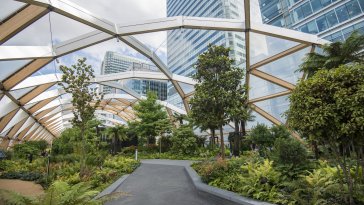
How companies are measuring their impact on nature
- 19 June 2024 (5 min read)
Like carbon intensity before it, the critical importance of nature for humanity and the impact our activities can have on it have been a growing topic for governments and businesses. Anna Vaananen, AXA’s head of listed impact equity, looks at how several companies in our impact portfolios – and AXA Group itself – are addressing the requirements to assess and report back on their use of natural capital.
2023 was a milestone year for biodiversity. COP 15 in New York set a clear roadmap for governments regarding the protection of biodiversity. 188 governments signed up to agree two goals: ‘stop biodiversity loss by 2030’ and ‘have a net positive impact on biodiversity by 2050’.
This can be compared to the milestone that the 2015 Paris Agreement was for climate change. Broad agreement on what needs to happen will facilitate action and positive change.
TNFD – a consistent metric for nature-based impacts
The second big milestone was the publication of the Taskforce for Nature Related Financial Disclosure (TNFD) recommendations in September 2023.
The TNFD is a global initiative that aims to provide a consistent reporting framework on how organisations affect the natural world. It’s hoped that this will highlight areas where capital can help create nature-positive outcomes aligned with the Global Biodiversity Framework that was adopted at COP 15.
It focuses on four pillars:
- Governance – how organisations manage dependencies, impacts, risks, and opportunities arising from nature
- Strategy – the effect of nature-related factors on an organisation’s business model, strategy, and financial planning
- Risk and impact management – how organisations assess and address nature-related risks and opportunities.
- Metrics and targets – how organisations set targets and measure progress
For investors, improving nature related disclosure will be a key measure for the effectiveness of their stewardship of the companies they invest in. Improving TNFD metrics will be an indicator for investors that they are helping to guide the companies they support to better outcomes.
Case studies: TNFD in practice
In January 2024, TNFD announced that 320 organisations from 46 countries had committed to starting to make nature-related disclosures based on its recommendations. This includes many big, listed companies, and an overall market capitalisation of over $4 trillion.
Every organisation is different and there are many ways to get started with nature-based disclosure. Many companies are already collecting data in key areas such as water use, pollution or deforestation, and this is a good starting point to gradually start to build up nature related mapping.
We asked some of the companies we know how they are addressing TNFD. Their testimonials, and our own experience as AXA Group, provide an illustration of the different approaches that are emerging.

AXA Group
Sector: Financial services
AXA Group has committed to adopting the TNFD recommendations early, with plans to disclose in 2026 based on 2025 results.
Having been involved in the initial move to create the TNFD in 2019, we continue to take part in its development. In 2023, AXA Group took part in a test of negative impact metrics from IceBerg Datalab, led by ICare Consulting, focusing on sectors such as agrifood. This pilot gave us a deeper understanding of negative impacts, dependencies, risks, and some opportunities for companies most affected, and provided insights into and potential engagement strategies.
Looking ahead, we are actively involved in discussions about further efforts to elevate nature's importance in disclosures, similar to what has been done for climate issues. This ongoing work aims to facilitate enhanced disclosure and engagement, ensuring that nature-related risks and opportunities are appropriately addressed in financial reporting.

Schneider Electric
Sector: Electrical equipment
Schneider Electric was among the first companies in the world to assess its end-to-end biodiversity footprint. This included:
- the supply chain
- its own operations
- the impact of its products across their useful lives.
The company conducted a comprehensive biodiversity footprint assessment in 2020, and a follow-up in 2023 to evaluate progress. These assessments have guided the company’s mitigation plans and targets for zero net biodiversity loss by 2030.
Using the TNFD framework, Schneider assessed its impacts on land, ocean, freshwater, and atmosphere, with climate change identified as the primary driver of biodiversity loss. The impact of land-use change, mainly related to supply chains and raw materials, was also highlighted.
Programmes to improve their biodiversity footprint include:
- targets to increase green material and recycled content in its products
- continued efforts to reduce greenhouse gas emissions from the use of their products
- managing impacts at the end of their product lifecycle, notably via retrofitting.
Source: Schneider Electric Universal Registration Document pp.186-207 2023 Universal Registration Document (se.com)
Hexagon AB
Sector: Electronic equipment
In early 2024, AXA IM engaged with Hexagon to encourage the company to integrate biodiversity considerations into its strategy. We were encouraged by their recognition of biodiversity as an opportunity to create value and its commitment to better reporting.
Hexagon acknowledges its significance for innovation and product development, and constantly seeks to use its technology as a force for good.
Notably, Hexagon's R-evolutions business arm has been developing applications to support rainforest conservation, using a combination of Hexagon capabilities through Earth Observation, Airborne LiDAR, terrestrial mapping and its digital reality platform ‘HxDR’. The first rainforest biodiversity corridor in Costa Rica has already been captured together with leading biodiversity researchers from University of Vienna and is available for sponsorship as “Green Cubes”. This will enable more accurate biodiversity measurement on a cubic meter basis.
Hexagon is not only using its competence to solve the nature-related challenges faced by the industries it serves, the company is also aiming to expand disclosure on biodiversity initiatives and implement recommendations from the Task Force on Nature-related Financial Disclosures (TNFD). This approach will enhance impact measurement, particularly for agricultural solutions, and align with plans to implement a biodiversity action plan across all major facilities, as outlined in its latest annual and sustainability report.
(source: Hexagon Annual and Sustainability Report 2023 p66 - 202403262178-1.pdf (alertir.com)).

Symrise
Sector: Specialty chemicals
The TNFD framework, and its Locate Evaluate Assess Prepare (LEAP) approach, plays a central role in Symrise’s corporate sustainability strategy and management system. The company analyses and assesses all material nature-related impacts and dependencies, in line with the assessment and reporting requirements of TNFD, science-based targets network (SBTN), and the Corporate Sustainability Reporting Directive (CSRD).
In its own operations, Symrise prioritises:
- Sustainable energy
- Water stewardship
- Waste management
- Investment in efficient processes
This has produced significant improvements in environmental KPIs, surpassing targets for reducing water consumption in water-stressed areas and enhancing eco-efficiency in climate and wastewater management.
The company not only assesses its supply chain and mitigates environmental risks, but also directly engages with suppliers of vanilla, patchouli, mint, banana, onion, carrot and many others. Over 95% of its strategic biological materials are now sourced sustainably, with plans for further engagement.
Symrise integrates principles of green chemistry and sustainable design in R&D to ensure product safety and environmental responsibility throughout the lifecycle. Additionally, it supports global initiatives like the World Business Council for Sustainable Development’s Nature Action and Sustainable Food workstreams, contributing to regenerative agriculture and alternative protein solutions.

CRODA
Sector: Specialty chemicals
AXA IM met with Croda’s chief sustainability officer to discuss on the company’s current thinking and work on the TNFD reporting recommendations. Nature related dependencies and impacts are not a new concept for Croda. About 60% of Croda’s raw materials are nature based so the company already has a good understanding on where the raw materials are sourced from.
Croda’s priorities for nature-related impact and dependencies are:
- Supply chains for palm oil, lanolin, corn and rapeseed: The company started to work towards sustainable supply chain in palm oil already in 2014. One of Croda’s main raw materials lanolin is a good example of circularity as the company takes a waste stream from the wool industry and uses it as a feedstock.
- Water use: the company has six manufacturing plants in water stressed areas and the company already has a roadmap to reduce water related impact at these locations by 25% by end of 2024.
The company has already made commitments in these areas.
Croda has completed two of the four stages, Locate and Evaluate, of the TNFD’s LEAP approach, and intends to issue its first report in 2026, using data from its performance in 2025.
We have confidence in Croda’s ability to formulate an industry-leading strategy to reduce its impacts on nature and accelerate its net-positive contribution to biodiversity, especially via its emerging portfolio of solutions enabling regeneration and harmful impact reduction.
Disclaimer
Not for Retail distribution: This marketing communication is intended exclusively for Professional, Institutional or Wholesale Clients / Investors only, as defined by applicable local laws and regulation. Circulation must be restricted accordingly. This document is for informational purposes only and does not constitute investment research or financial analysis relating to transactions in financial instruments as per MIF Directive (2014/65/EU), nor does it constitute on the part of AXA Investment Managers or its affiliated companies an offer to buy or sell any investments, products or services, and should not be considered as solicitation or investment, legal or tax advice, a recommendation for an investment strategy or a personalized recommendation to buy or sell securities.
Due to its simplification, this document is partial and opinions, estimates and forecasts herein are subjective and subject to change without notice. There is no guarantee forecasts made will come to pass. Data, figures, declarations, analysis, predictions and other information in this document is provided based on our state of knowledge at the time of creation of this document. Whilst every care is taken, no representation or warranty (including liability towards third parties), express or implied, is made as to the accuracy, reliability or completeness of the information contained herein. Reliance upon information in this material is at the sole discretion of the recipient. This material does not contain sufficient information to support an investment decision.
Companies shown are for illustrative purposes only as of 31 May 2024 and may no longer be in the portfolio later. It does not constitute investment research or financial analysis relating to transactions in financial instruments, nor does it constitute an offer to buy or sell any investments, products or services, and should not be considered as solicitation or investment, legal or tax advice, a recommendation for an investment strategy or a personalized recommendation to buy or sell securities.
The information contained herein is based on the companies’ commitment toward climate transition and is not a reliable indicator of their future financial results.
Issued in the UK by AXA Investment Managers UK Limited, which is authorised and regulated by the Financial Conduct Authority in the UK. Registered in England and Wales No: 01431068. Registered Office: 22 Bishopsgate London EC2N 4BQ
In other jurisdictions, this document is issued by AXA Investment Managers SA’s affiliates in those countries.
Risk Warning
The value of investments, and the income from them, can fall as well as rise and investors may not get back the amount originally invested.





